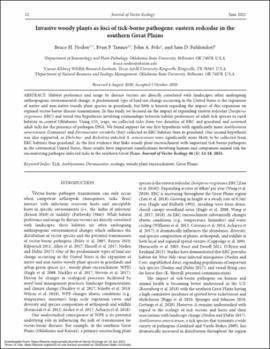| dc.contributor.author | Noden, Bruce H. | |
| dc.contributor.author | Tanner, Evan P. | |
| dc.contributor.author | Polo, John A. | |
| dc.contributor.author | Fuhlendorf, Sam D. | |
| dc.date.accessioned | 2022-04-12T13:50:50Z | |
| dc.date.available | 2022-04-12T13:50:50Z | |
| dc.date.issued | 2021-06 | |
| dc.identifier | oksd_noden_invasivewoodyplants_2021 | |
| dc.identifier.citation | Noden, B. H., Tanner, E. P., Polo, J. A., & Fuhlendorf, S. D. (2021). Invasive woody plants as foci of tick-borne pathogens: Eastern redcedar in the southern Great Plains. Journal of Vector Ecology, 46(1), pp. 12-18. https://doi.org/10.52707/1081-1710-46.1.12 | |
| dc.identifier.uri | https://hdl.handle.net/11244/335175 | |
| dc.description.abstract | Habitat preference and usage by disease vectors are directly correlated with landscapes often undergoing anthropogenic environmental change. A predominant type of land use change occurring in the United States is the expansion of native and non-native woody plant species in grasslands, but little is known regarding the impact of this expansion on regional vector-borne disease transmission. In this study, we focused on the impact of expanding eastern redcedar (Juniperus virginiana; ERC) and tested two hypotheses involving relationships between habitat preferences of adult tick species in rural habitats in central Oklahoma. Using CO2 traps, we collected ticks from two densities of ERC and grassland and screened adult ticks for the presence of pathogen DNA. We found support for our first hypothesis with significantly more Amblyomma americanum (Linnaeus) and Dermacentor variabilis (Say) collected in ERC habitats than in grassland. Our second hypothesis was also supported, as Ehrlichia-and Rickettsia-infected A. americanum were significantly more likely to be collected from ERC habitats than grassland. As the first evidence that links woody plant encroachment with important tick-borne pathogens in the continental United States, these results have important ramifications involving human and companion animal risk for encountering pathogen-infected ticks in the southern Great Plains. | |
| dc.format | application/pdf | |
| dc.language | en_US | |
| dc.publisher | Society for Vector Ecology | |
| dc.relation.ispartof | Journal of Vector Ecology, 46 (1) | |
| dc.relation.uri | https://www.ncbi.nlm.nih.gov/pubmed/35229576 | |
| dc.rights | This material has been previously published. In the Oklahoma State University Library's institutional repository this version is made available through the open access principles and the terms of agreement/consent between the author(s) and the publisher. The permission policy on the use, reproduction or distribution of the material falls under fair use for educational, scholarship, and research purposes. Contact Digital Resources and Discovery Services at lib-dls@okstate.edu or 405-744-9161 for further information. | |
| dc.title | Invasive woody plants as foci of tick-borne pathogens: Eastern redcedar in the southern Great Plains | |
| dc.date.updated | 2022-04-07T14:07:02Z | |
| osu.filename | oksd_noden_invasivewoodyplants_2021.pdf | |
| dc.description.peerreview | Peer reviewed | |
| dc.identifier.doi | 10.52707/1081-1710-46.1.12 | |
| dc.description.department | Entomology and Plant Pathology | |
| dc.description.department | Natural Resource Ecology and Management | |
| dc.type.genre | Article | |
| dc.type.material | Text | |
| dc.subject.keywords | Amblyomma | |
| dc.subject.keywords | Dermacentor | |
| dc.subject.keywords | Great Plains | |
| dc.subject.keywords | Tick | |
| dc.subject.keywords | ecology | |
| dc.subject.keywords | woody plant encroachment | |
| dc.subject.keywords | Vector-Borne Diseases | |
| dc.subject.keywords | Infectious Diseases | |
| dc.subject.keywords | 06 Biological Sciences | |
| dc.subject.keywords | 11 Medical and Health Sciences | |
| dc.subject.keywords | Tropical Medicine | |
| dc.identifier.author | ORCID: 0000-0002-0096-370X (Noden, BH) | |
| dc.identifier.author | ScopusID: 6601968347 (Noden, BH) | |
| dc.identifier.author | ORCID: 0000-0003-0063-7004 (Tanner, EP) | |
| dc.identifier.author | ScopusID: 56596335600 (Tanner, EP) | |
| dc.identifier.author | ScopusID: 55544602100 (Polo, JA) | |
| dc.identifier.author | ORCID: 0000-0002-8726-9402 (Fuhlendorf, SD) | |
| dc.identifier.author | ScopusID: 6701336850 (Fuhlendorf, SD) | |
